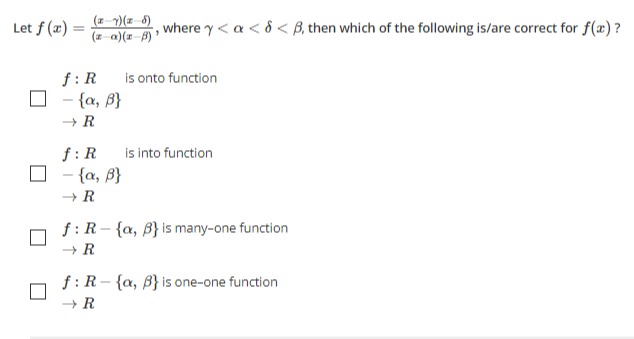Question
Question: Let $f(x) = \frac{(x-\gamma)(x-\delta)}{(x-\alpha)(x-\beta)}$, where $\gamma < \alpha < \delta < \be...
Let f(x)=(x−α)(x−β)(x−γ)(x−δ), where γ<α<δ<β, then which of the following is/are correct for f(x)?

f:R−{α,β}→R is onto function
f:R−{α,β}→R is into function
f:R−{α,β}→R is many-one function
f:R−{α,β}→R is one-one function
f: R - {α, β} → R is onto function, f: R - {α, β} → R is many-one function
Solution
The given function is f(x)=(x−α)(x−β)(x−γ)(x−δ), with the condition γ<α<δ<β. The domain of the function is R−{α,β}, as the denominator cannot be zero.
-
Behavior as x→±∞:
As x→±∞, f(x)=x2−(α+β)x+αβx2−(γ+δ)x+γδ→x2x2=1.
So, y=1 is a horizontal asymptote. -
Behavior near vertical asymptotes:
- As x→α+:
Numerator: (x−γ)(x−δ)→(α−γ)(α−δ). Since γ<α<δ, α−γ>0 and α−δ<0. So, numerator →negative.
Denominator: (x−α)(x−β)→(0+)(α−β). Since α<β, α−β<0. So, denominator →0−.
Thus, f(x)→negative smallnegative→+∞. - As x→α−:
Numerator: (α−γ)(α−δ)→negative.
Denominator: (x−α)(x−β)→(0−)(α−β)→0+.
Thus, f(x)→positive smallnegative→−∞. - As x→β+:
Numerator: (x−γ)(x−δ)→(β−γ)(β−δ). Since γ<δ<β, both β−γ>0 and β−δ>0. So, numerator →positive.
Denominator: (x−α)(x−β)→(β−α)(0+). Since α<β, β−α>0. So, denominator →0+.
Thus, f(x)→positive smallpositive→+∞. - As x→β−:
Numerator: (β−γ)(β−δ)→positive.
Denominator: (x−α)(x−β)→(β−α)(0−)→0−.
Thus, f(x)→negative smallpositive→−∞.
- As x→α+:
-
Roots of f(x):
f(x)=0 when (x−γ)(x−δ)=0, so x=γ or x=δ. These are the x-intercepts. -
Injectivity (One-one/Many-one):
Since f(x)→1 as x→−∞ and f(x)→1 as x→+∞, and the function takes values other than 1 (e.g., f(γ)=0, f(δ)=0), it cannot be one-one.
Also, f(x)=1 has a solution x0=γ+δ−(α+β)γδ−αβ. This x0 is distinct from α and β.
Since f(x) approaches 1 from above as x→+∞ and from below as x→−∞ (if x0 is not between α and β), it means that for some value y0 close to 1, there will be multiple x values such that f(x)=y0.
For example, f(x) goes from 1 to 0 in (−∞,γ) and from 1 to 0 in (β,+∞). This implies that for any y∈(0,1), there are at least two values of x for which f(x)=y.
Therefore, f(x) is a many-one function. -
Surjectivity (Onto/Into):
The range of f(x) is the union of the ranges over the intervals:- (−∞,γ): (0,1) (excluding 1, including 0)
- (γ,α): (−∞,0) (excluding 0)
- (α,δ): (0,+∞) (excluding 0)
- (δ,β): (−∞,0) (excluding 0)
- (β,+∞): (1,+∞) (excluding 1)
The union of these ranges is (−∞,∞)=R.
Since the codomain is R, and the range is R, the function is onto.
Based on the analysis:
- f:R−{α,β}→R is an onto function.
- f:R−{α,β}→R is a many-one function.
